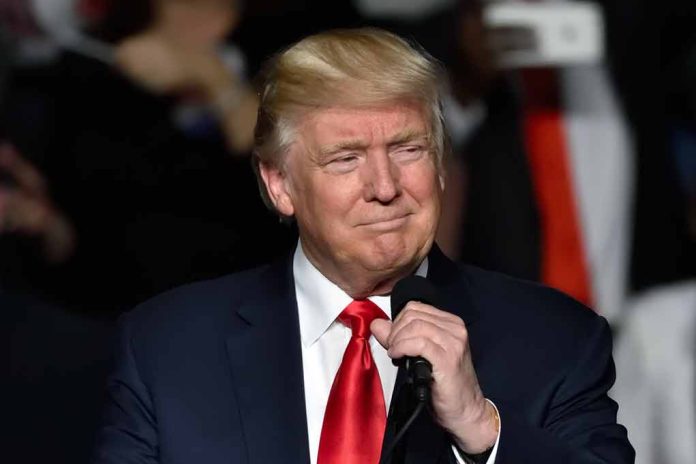
President Trump signs executive order targeting sanctuary cities that could strip federal funding from jurisdictions refusing to cooperate with immigration authorities, sending shockwaves through communities nationwide.
Key Takeaways
- Trump’s new executive order threatens to withhold federal funding from sanctuary jurisdictions that obstruct federal immigration enforcement efforts
- The Department of Justice is mandated to compile a list of non-compliant sanctuary jurisdictions across the country
- Attorney General Pam Bondi and DHS Secretary Kristi Noem will pursue legal actions against cities that refuse to comply
- The order aims to speed up deportations and prevent sanctuary city residents from receiving federal public benefits
- Major cities like Chicago, New York, Boston, and Los Angeles, as well as states like California and Illinois, maintain sanctuary policies
Federal Crackdown on Sanctuary Jurisdictions
President Donald Trump has taken decisive action against sanctuary cities by signing an executive order that threatens to cut off federal funding to jurisdictions that refuse to cooperate with immigration authorities. The order, signed yesterday at the White House, follows through on one of Trump’s key campaign promises to accelerate deportations and enforce immigration laws more stringently. The measure specifically targets cities and states that limit their cooperation with Immigration and Customs Enforcement (ICE), effectively hindering federal efforts to remove individuals who have entered the country illegally.
According to White House officials, the executive order mandates the Justice Department to create a comprehensive list of sanctuary jurisdictions across the United States. These identified areas will face the prospect of losing critical federal funding unless they begin complying with federal immigration laws. Major metropolitan areas potentially affected include Chicago, New York City, Boston, and Los Angeles, along with entire states like California, Oregon, Washington, and Illinois that have enacted various sanctuary protections at the state level.
President Donald Trump signed an executive order Monday that directs federal and state officials to compile lists of so-called "sanctuary" jurisdictions and prepare to cut their federal funds. https://t.co/cFXhl3pJ38
— LEX 18 News (@LEX18News) April 29, 2025
Administration Officials Empowered to Act
The executive order empowers Attorney General Pam Bondi and Department of Homeland Security Secretary Kristi Noem to pursue legal actions against cities that refuse to comply with federal immigration enforcement. This approach represents a significant escalation in the administration’s efforts to enforce immigration laws uniformly across the country. The order addresses what the administration calls a “lawless insurrection” by state and local officials who actively obstruct federal immigration policies designed to protect American communities.
“It’s quite simple: obey the law, respect the law, and don’t obstruct federal immigration officials and law enforcement officials when they are simply trying to remove public safety threats from our nation’s communities. The American public don’t want illegal alien criminals in their communities. They made that quite clear on November 5, and this administration is determined to enforce our nation’s immigration laws,” White House Press Secretary Karoline Leavitt said.
The administration’s approach includes a grace period, allowing sanctuary jurisdictions the opportunity to change their policies and comply with federal law before funding cuts are implemented. This measured approach aims to encourage cooperation rather than immediate punitive action. The White House has emphasized that the goal is to restore a functional immigration system that prioritizes public safety and respects the rule of law.
Public Benefits and Safety Concerns
Beyond restricting federal funding, the executive order also seeks to prevent residents of sanctuary jurisdictions from receiving federal public benefits. This additional measure intensifies pressure on local governments that maintain sanctuary policies. The White House has cited numerous examples of sanctuary jurisdictions refusing to honor ICE detainer requests, which they claim has resulted in preventable crimes committed by individuals who should have been deported.
“These reckless policies in Democrat-run cities and states across our nation have led to too many preventable tragedies. They also endanger ICE agents who are forced to take more difficult enforcement actions in jurisdictions that refuse to cooperate with federal immigration authorities.” said the House Committee on Oversight and Government Reform Chairman James Comer, R-Ky.
The executive order comes amid increasing tensions between federal authorities and sanctuary jurisdictions, highlighted by recent congressional hearings. President Trump has consistently criticized sanctuary policies, arguing they endanger public safety by protecting individuals who have violated immigration laws. This latest action is part of a broader immigration enforcement strategy, with the administration having signed over 140 executive orders in its first 100 days in office, many focusing on border security and immigration enforcement.
Local Responses and Adaptations
Some sanctuary cities are already showing signs of adjusting their policies in response to federal pressure. New York City Mayor Eric Adams recently modified certain aspects of the city’s sanctuary policies, allowing ICE to operate at Rikers Island jail complex for criminal matters. This partial cooperation demonstrates the complex balancing act facing local officials as they attempt to maintain community trust while avoiding direct conflict with federal authorities on immigration enforcement.
“No more Sanctuary Cities! They protect the Criminals, not the Victims. They are disgracing our Country, and are being mocked all over the World. Working on papers to withhold all Federal Funding for any City or State that allows these Death Traps to exist,” President Donald Trump said.
Legal challenges to the executive order are anticipated, as previous attempts to restrict federal funding to sanctuary jurisdictions faced constitutional obstacles. A federal judge previously blocked similar efforts, citing constitutional violations related to the separation of powers and federal overreach into state and local governance. Despite these potential legal hurdles, the administration appears determined to proceed with enforcement actions against jurisdictions it considers non-compliant with federal immigration laws.
Sources:
- Trump signs executive order highlighting sanctuary cities fighting immigration enforcement
- Trump signs executive order cracking down on ‘sanctuary’ cities, threatens their federal funding
- Trump Puts Sanctuary Cities On Notice With New Executive Order














